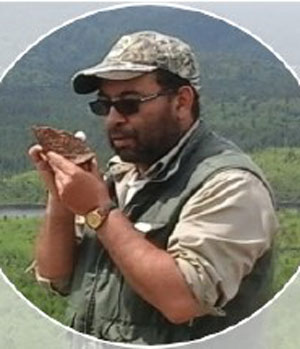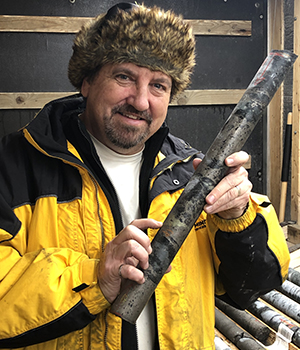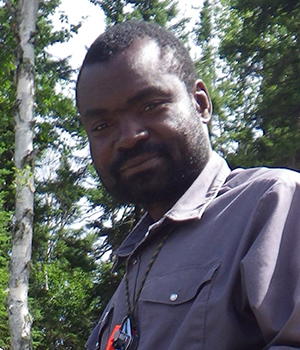The Grenville Province is known for its varied mineralization. During this session, Géologie Québec and its university and industry partners will present the latest research results on rare earth elements, nickel, copper, iron, titanium, and phosphorus mineralization identified in this province of great potential. Results and hotspots from the latest geoscientific knowledge acquisition surveys (mapping and geophysical surveys) carried out in the Grenville during the summer of 2023 will also be featured.
Grenville Province: a Geological Province to Discover for its Mineral Potential in Critical and Strategic Minerals
Tuesday, November 21, 2023
Room 403 - Geoscientific Pavilion


1:05 p.m.
Study of Rare Earth Elements ±Nb ±Ta Mineralization, Central Part of the Grenville Province, Quebec, Canada

MRNF
Authors: Abdelali Moukhsil and Mhamed El Bourki (MRNF)
In the summer of 2023, three sectors of the Grenville Province were surveyed for indexes of rare earth elements (REE) ± Nb + Th ± Y ± Zr. Sector I is located in the area of the Daniel Johnson reservoir on the Moyenne-Côte-Nord (NTS sheets 22K06, 22K07, 22K10, 22K11 and 22K15), sector II is located to the north and NW of the Lac-Saint-Jean region (sheets 32A15, 32H01, 32H/02, 32H07 and 32H08), while sector III is located to the NW of the town of La Tuque (sheets 31P11, 31P14, 32A03, 32A04 and 32B01).
The first step in this study was to compile mineralizations of this type throughout the Quebec portion of the Grenville Province. This compilation deals with the characteristics of each index, particularly the mineralogy (mineralization-bearing minerals, associated minerals), the host rocks, the age of mineralization, the mode of emplacement, etc. In a second phase, which began in the summer of 2023, several indexes were the subject of a more in-depth study involving detailed mapping, microXRF and microprobe analysis of mineralized samples, geochronological (U-Pb) and isotopic (Hf-Lu isotopes) studies. The aim of this work is to characterize these mineralizations in order to assign them to the various existing classifications and to define the metallogenic environments in which they were emplaced. The REE ± Nb + Th ± Y ± Zr indexes in the three sectors studied and in the Grenville Province in general are associated with specific host rocks (granitic pegmatite dykes, pegmatitic or coarse-grained syenite dykes with or without nepheline, granitic or syenitic plutons, carbonatite dykes). They are characterized by the prevalence of allanite or monazite and the presence of rare earth carbonates (parisite, bastnäsite), thorite, apatite and xenotime. These characteristics vary from one sector to another, independently of the age of the host rocks or the nature of the host cut by mineralized dykes (intrusions and/or paragneiss). In sector I, the dykes have been dated to the late Grenville period (1005 to 960 Ma), whereas in sectors II and III, the ages of emplacement correspond to the middle and late Grenville (between 1090 and 1020 Ma).
1:25 p.m.
Granitic Pegmatites Enriched in Light Rare Earths from the Haute-Mauricie and Northern Lac-Saint-Jean Regions: Ages, Sources and Enrichment Processes

Université Laval
Authors: Bertrand Rottier, Pedro Alves, Samuel Coulombe, Carl Guilmette, Antoine Godet, Théo Royet, Christian Dupuis (Université Laval), Abdelali Moukhsil (MRNF), Joshua Davies, Morgann Perot (UQAM) and Jeffrey Marsh (Université Laurentienne)
Non-deformed to slightly deformed post-tectonic granitic pegmatite dykes are common in high-grade metamorphic (amphibolite to granulite) orogenic belts. Some of these dykes show notable enrichments of light rare earths (REE), Nb, Ta, Th and U, which generally have no temporal and/or spatial relationship with granitic intrusions. This lack of genetic link raises questions about the source of the mineralizing magmas and the enrichment processes for critical metals in these granitic magmas. The Grenville Geological Province provides a perfect laboratory for understanding the genesis of these REE-rich pegmatites because of the large number of mineralized dykes located within the Allochthon Mid-P belt. For this study, nine granitic pegmatites rich in light REE (between 0.3 and 2.8% REE content by weight) in the Haute-Mauricie and northern Lac-Saint-Jean regions were dated (U-Pb on zircon) and mineralogically and chemically characterized. These intrusions form isolated metric dykes or vein systems that can be kilometres in size. They cut indiscriminately through all the lithologies of the region (granitic gneiss, paragneiss and gabbronorite) without these having any impact on the chemical composition of the pegmatites. Furthermore, REE-rich pegmatites show no spatial relationship with the syngrenvillian to late-grenvillian alkaline intrusions present in the region. Geochronological data indicate that these pegmatites were emplaced during two distinct episodes, the first between ~1060 Ma and ~1045 Ma and the second between ~1010 Ma and ~990 Ma, currently interpreted as representing two events of magma production by anatexis of pre-Grenvillian rocks. A detailed study of the Hf isotopic signature of zircons from the REE-rich pegmatite of Blanchette-1 indicates that the source of the mineralizing magma was the partial melting of granitic gneiss from the Vermillion Complex. These results contrast with the metasedimentary source proposed for the REE-rich pegmatites of Lac Okaopéo, suggesting that the nature of the partially melted source rocks is not a determining factor in the formation of REE-rich granitic pegmatites. Within the pegmatites, mineralization is carried by allanite, locally accompanied by monazite and pyrochlore. REE enrichment in these pegmatites is strongly zoned within the dykes and decoupled from major element zonation.
1:45 p.m.
Polyphased History of the Saint Honoré Nb-(REE) Ore Deposit: Insights from Apatite Chemistry

Authors: Hélène Legros (MRNF-UQAC), Sarah Dare and L. Paul Bédard (UQAC)
Niobium resources are critical worldwide and in Québec. Niobium is mainly used to make alloys for the aeronautic industry. Carbonatites and their altered products are the main host of niobium. The Saint Honoré deposit (Saguenay, Québec) is currently being exploited for its niobium-rich carbonatite (560 Ma to 575 Ma). The deposit is mined by Niobec and represents 9% of the world’s production. At Saint Honoré, the main ore mineral is pyrochlore ([Ca,Na]2[Nb,Ti]2O6[O,OH,F]). To this day, no dating method has been developed to date this mineral. However, pyrochlore at Saint Honoré is closely associated with apatite, which is an excellent mineral to trace processes and for U-Pb dating. The aim of this study is to use apatite chemistry to define the magmatic and hydrothermal processes at Saint Honoré, try to understand the relation of these processes with the mineralization and to date both mineralization processes for the first time.
We described three generations of apatite at Saint Honoré, including two types that are observed within the mineralized carbonatite. These two apatites have distinctive colors: white and red. The white apatite is an igneous apatite and is correlated to the crystallization of the main niobium mineral. The red apatite is hydrothermal and forms veins that crosscut the mineralized rocks. This hydrothermal event might be responsible for the alteration of pyrochlore into columbite. Geochemical analyses of the apatite allowed to show different processes associated with the igneous and hydrothermal stages. U-Pb dating of the two apatites by LA-QQQ-ICP-MS (LabMaTer, UQAC) showed that the two stages are decorrelated in time with ca. 35 Ma in between. The crystallization of the magmatic apatite is associated with the emplacement of the carbonatite whereas the hydrothermal event is linked to external fluids.
2:05 p.m.
Grall, a Ni-Cu-Co Deposit Under Development in the Saguenay–Lac-Saint-Jean region

GoldMinds Geoservices
The Graal Property (the “Property” or “Graal”) is located in the north of Saguenay Lac St-Jean region. It is comprised of 110 map-designed claims covering 6,113 hectares. The Property is located 160 kilometers NNE of the city of Saguenay and 272 kilometers east of Chibougamau in NTS 22E15 and 22E10. The Property has a latitude 49º 47’ North and longitude 70º 50’ West. The center point of the Property is at UTME 386635 / UTMN 5517695 (NAD83 Zone 19).
Portions of the Property were previously owned by Virginia Gold Mines Inc. (“Virginia”), Soquem and by Globex Mining Enterprises Inc (“Globex”). Exploration and mapping work on the Property were initiated in the 1970’s by the Ministère de l’Énergie et des Ressources Naturelles (“MERN”) and NQN Mines Ltd respectively. CCW is 100%-owner of the Property since 2022.
The Property lies within the Grenville Province. Most of the rocks on Graal consist in ultramafic to mafic magmatic complex belonging to the Lac-Saint-Jean Anorthositic Suite (“LSJAS”). These rock packages are dated from Proterozoic. The two main mineralization types found on the Property are Fe-Ti-P deposits and Ni-Cu-PGE massive sulfides. Both of these metallogenic models involve immiscibility of concerned substances from the original melt due to various geological processes.
An airborne gravity survey was undertaken in 2021 followed by two (2) phases of diamond drilling program summing up to 23,830.85m drilled and which was held between 2021 and summer 2022. A SQUID over MHY zone followed the promising surface TDEM results from earlier in 2022 and which also covered MHY on top of Gravi zone. The combined results and interpretation from these integrated geophysical methodologies participated in design of the on-going and following exploration drilling programs.
First phase of 2021-2022 drilling program comprised 32 holes (NRC-21-01 to NRC-22-29 included) including 3 wedged holes.
Second phase of drilling program started in spring 2022 and ended in summer 2022. This phase comprised 32 holes (GRL-22-30 to GRL-22-61 included).
The first hole (NRC-21-01) and the 3 wedged holes aimed at intersecting the center of kilometric Bouguer gravity anomaly (~1500m of diameter). The hole and associated wedges failed to intersect the target due to a major fault at depth.
CCW discovered a new zone (Discovery Zone) with massive sulfides 2500m northwest of the known historical mineralization (MHY Nord showing). The 2021-2022 drilling program also increased the extent of the Ni-Cu mineralized footprint of MHY Nord (MHY Zone) and MHY Ap (Gravi Zone) showings. Best composite grades from the 2021-2022 campaign are 0.84% Ni, 0.59% Cu and 0.09% Co over 5.7m in NRC-21-03 (Discovery Zone), 0.32% Ni, 0.45% Cu and 0.04% Co over 33.6m in NRC-22-24 (Gravi Zone) and 0.73% Ni, 0.41% Cu and 0.09% Co over 5.7m in GRL-22-60 (MHY Zone).
2:25 p.m.
Exploration for Critical and Strategic Minerals: What Can We Learn from the Saguenay–Lac-Saint-Jean Carbonatites?

CERM-UQAC
Authors: L. Paul Bédard, Nils Van Weelderen, Renée-Luce Simard, Charles Saint-Laurent (UQAC), Anne-Aurélie Sappin (CGC-Québec) and Michel Grégoire (Géosciences Environnement Toulouse)
Most major economies are investing significant efforts to improve access to critical and strategic minerals as part of the energy transition. This move towards a clean economy is creating strong demand for a number of elements such as rare earth elements (REEs), niobium, phosphorus and others. Carbonatites are rich in these substances, making them prime targets for mineral exploration. Carbonatites are rare mantle rocks that form small-volume intrusions, particularly in the Saguenay-Lac-Saint-Jean region (Saint-Honoré, Shipshaw, Crevier and Girardville). The Saint-Honoré and Crevier intrusions have economic grades of Nb, Ta and REE. Two episodes of carbonatitic magmatism have been recognized in the sector: ~950 Ma (Crevier and Girardville) and ~580 Ma to 550 Ma (Saint-Honoré and Shipshaw). Carbonatites with economic grades of critical minerals are associated with large alkaline complexes (surface expression of more than 20 km2), whereas the Shipshaw and Girardville carbonatites occur as small dykes (<100 m2). Most of the carbonatites are associated with syenite units. Their composition varies from Ca-carbonatite, Mg-carbonatite to Fe-carbonatite, with the largest intrusions showing more variety. Pyrochlore (in the broadest sense) and its alteration product, columbite-Fe, are the main Nb minerals, while bastnäsite-(Ce) and parisite – (Ce) are the main rare-earth-bearing minerals.
Low-volume carbonatite dykes represent simpler environments than alkaline complexes. They are useful to determine and better understand mineralization phenomena. The hypotheses derived from these studies can then be tested on larger carbonatites associated with economic mineralization. Recent research has highlighted two trends in mineralized carbonatitic systems. Firstly, carbonatites containing economic levels of Nb are found near or in contact with silicate rocks (e.g. syenites). The contact reactions between these two lithological types appear to represent favourable conditions for the abundant crystallization of pyrochlore. Secondly, economic REE values are found in Fe-rich and Ba-rich carbonatite units (up to 14% BaO). These two observations could be very useful criteria for the exploration of these substances.
2:45 p.m.
Break
Authors: Sarah Dare, Pedro Miloski, Théo Hassen Ali, Renée-Luce Simard (UQAC) and Abdelali Moukhsil (MRNF)
Proterozoic anorthosite-mangerite-charnockite-granite (AMCG) massifs are common in the Grenville Province of Quebec. These massifs host orthomagmatic Fe-Ti-V-P (associated with ilmenite, hemo-ilmenite, magnetite and apatite) and Ni-Cu-Co (associated with magmatic sulphides) mineralization, all of which are potential sources of critical and strategic metals. The type of mineralization appears to be associated with the age of the host anorthosite suite. Older anorthosites (Geon 11), such as the Lac-Saint-Jean Anorthositic Suite (1.16 to 1.14 Ga), contain Ni-Cu-Co and Fe-Ti-V-P mineralizations dominated by magnetite. Younger anorthosites (Geon 10), such as Vanel, Mattawa and Labrieville, contain more Fe-Ti-P mineralizations dominated by hemo-ilmenite.
The Lac-Saint-Jean Anorthositic Suite in central Grenville is one of the largest anorthositic massifs in the world. It was probably emplaced in the form of multiple lobes/intrusions. The mineralogy of these lobes is variable (plagioclase of labradorite composition containing andesine; orthopyroxene or olivine as a ferromagnesian mineral) and their spatial distribution is still very poorly understood. Work in progress at UQAC, in collaboration with the MRNF, is aimed at improving identification of the relationships between mineralization and the host rocks through detailed mapping of anorthositic facies and chemical mapping of plagioclase using portable X-ray fluorescence (XRF). A better understanding of the relationship between mineralization and the host rocks would improve exploration models for orthomagmatic deposits in the AMCG suites in Quebec.
3:20 p.m.
Geology of the Lac de la Fourche Region, Grenville Province, Mauricie and Saguenay–Lac-Saint-Jean Regions, Quebec, Canada

MRNF
Authors: Francis Talla Takam and Abdelali Moukhsil (MRNF)
The Lac de La Fourche sector (NTS sheet 32A03), to the NW of La Tuque, straddles the Haute-Mauricie and Lac-Saint-Jean regions.
The rocks in the area mapped in this sector are part of the Allochthon of the Grenville Province and are Mesoproterozoic in age. The crystalline basement, formed by the intermediate to felsic gneissic intrusive rocks of the Bardeau Plutonic Suite (1364 ± 9 Ma), outcrops in the extreme east of the sheet. This unit is in sheared contact with the Pope Plutonic Suite (1350 ± 4 Ma), which covers most of the sheet and underlies the supracrustal unit of the Wabash Complex (<1204 ± 4 Ma). These different lithodemic units are injected by intrusions defined following our work in the summer of 2022: the Windigo Intrusions, the Wenache Pluton and the Cristal Batholith. Other intrusions, including the Bonhomme Plutonic Suite (1030 ± 19 Ma), the Rhéaume Intrusive Suite (1019 ± 2 Ma) and the Roc Suite (> 1012 ± 1 Ma) also outcrop in the region. All these rocks are cut by granitic to syenitic pegmatite dykes.
These lithological units are generally deformed, especially in the contact zones between intrusions and in shear zones and corridors. The regional structural grain is mainly oriented NE-SW, but the rocks in the region have undergone several deformation phases and are cut by major faults and strike-slip zones. Four structural domains, including three new ones, have been defined: the Ministic Structural Domain in the east, characterized by a medium ENE-WSW planar fabric with a moderate to steep dip, lineations with a horizontal component and folds overturned towards the NW; the Cristal Structural Domain in the central north, which shows a planar fabric with a radial disposition; the Wenache Structural Domain, limited to the pluton of the same name, whose planar structures have an axial plane lineation and define a vertical fold with an E-W subvertical axis; and the Windigo Structural Domain, which is characterized by a tectonometamorphic foliation, a mylonitic foliation or banding and a medium N-S trending, steeply east-dipping gneissosity. This domain is cut by a major deformation corridor, the Windigo Shear Zone, which is oriented N-S with a sinistral movement.
Regional metamorphism varies from granulitic to upper amphibolite facies. Along the Windigo Shear Zone, retrograde metamorphism is observed and marked by the uralitization of orthopyroxene, which is locally coronitic with borders of clinopyroxene ± amphibole ± garnet, superimposed by a hydrothermal alteration phenomenon.
Several mineralized zones suitable for exploration have been identified in this hydrothermal alteration corridor and in the Cristal Batholith:
- The FT-1057 zone is mineralized in heavy REE, Nb and Ta and found in a metric dyke of granitic pegmatite in contact with a major fault. The mineralization is hosted by allanite.
- The FT-1065 zone is mineralized in REE ± Th and found in a decimetric apatite syenite dyke.
- The Lac Benès prospective zone, with a graphite ± zinc mineralization found in metasedimentary rocks of the Wabash Complex.
- The Fe-Ti ± P ± V mineralization in the gabbronorites of the Cristal Batholith.
3:40 p.m.
Geology and Economic Potential of the Île-du-Grand-Calumet Region (NTS 31F10), Grenville Province, Ottawa region

MRNF
A new geological survey on a 1:20,000 scale was carried out in the summer of 2021 in the Île-du-Grand-Calumet region (eastern half of sheet 31F10), located approximately 90 km NW of the city of Gatineau. The purpose of the project was to acquire new geological knowledge in this part of the Grenville Province, known for its potential for critical and strategic minerals (CSMs). The new geological map also incorporates the results of mapping and mineral exploration work carried out in the region over almost a century.
Most of the area mapped is composed of the Ottawa Supracrustal Sequence, consisting essentially of marble and paragneiss. The southern part of Île-du-Grand-Calumet is mainly composed of amphibolite derived from basalt and metagabbro from the Grand-Calumet Complex (1232 Ma) and associated mafic intrusions. The metasedimentary rocks are cut by the mafic intrusions of the Chenaux Suite (1231 Ma), as well as by the intermediate to felsic Schwartz (1254 Ma), Litchfield (1222 Ma) and Rocher-Fendu (1195 Ma) intrusive suites. The rocks have undergone a complex structural evolution; they are affected by at least two deformation phases and by moderate to high-grade regional metamorphism. The region is subdivided into different structural domains, all bounded by faults or shear zones.
The region is known to host a number of CSM mineralized zones, including the former New Calumet mines, a polymetallic deposit exploited for its zinc resources, and the Cowan nickel mine. Other zinc and industrial mineral showings and deposits have been discovered in carbonate metasedimentary rocks and have since been the subject of mining or development work. This new geological inventory has led to the discovery of new showings and the enhancement of previously recognized potential for various types of mineralization: 1) polymetallic mineralization in metasedimentary rocks, 2) copper iodes, 3) potential for rare earth mineralization in potassic rocks and 4) potential for Cu-Ni and Fe-Ti-V mineralization in mafic intrusions.
Authors: Rachid Intissar and Siham Benhamed (MRNF)
Pursuing its mission of acquiring and processing geoscientific data, Géologie Québec has published the results of two new geophysical surveys carried out during the year. The ultimate goal of this work is to provide a support tool for geological mapping, both for Géologie Québec projects and for its mining industry clients. The data will also stimulate private investment by generating new prospective zones for mineral exploration. The results of these surveys, together with some preliminary qualitative interpretations, will be presented in this presentation. The following documents containing the digital data and technical reports are published in Examine:
- DP 2023-01: Airborne magnetic and spectrometric survey in the Lac Simard sector, south of Rouyn-Noranda (published in PDAC 2023).
-DP 2023-02: Aeromagnetic survey in the Aguanish River sector, Côte-Nord (published for Québec Mines + Énergie 2023).

